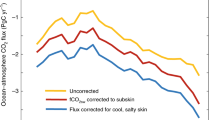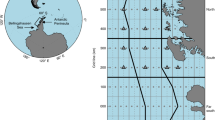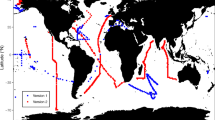Abstract
About half of the ‘anthropogenic’ CO2 emitted to the atmosphere is taken up by the oceans and terrestrial biosphere1, and the amount sequestered by the ocean is generally estimated using numerical ocean carbon-cycle models2. But these models often differ markedly3, resulting in different estimated spatial and temporal patterns and magnitudes of uptake. Because of its importance climatically, the CO2 flux needs to be verified using field measurements. Accurate estimates of CO2 uptake have been difficult to obtain, however, as the annual increase of dissolved inorganic carbon (DIC) concentration in surface water due to anthropogenic input is ∼0.05% of the total DIC, an order of magnitude lower than past measurement precision. Early measurement-based estimates4,5 of total anthropogenic CO2 inventory in the ocean have recently been improved on6,7, and new approaches have been proposed for determining changes in ocean DIC concentration over one to two decades8,9. Here we use recent improvements in DIC measurement techniques to determine changes in DIC concentrations between 1978 and 1995 in the Indian Ocean. Our method subtracts decadal-scale natural variability, enabling the ocean anthropogenic CO2 increase in this region over the 17-year period to be determined. The calculated uncertainties and known measurement capabilities allow us to define the minimum sampling strategies that will be required to quantify the regional and global anthropogenic CO2 oceanic uptake over future decades.
This is a preview of subscription content, access via your institution
Access options
Subscribe to this journal
Receive 51 print issues and online access
$199.00 per year
only $3.90 per issue
Buy this article
- Purchase on Springer Link
- Instant access to full article PDF
Prices may be subject to local taxes which are calculated during checkout


Similar content being viewed by others
References
Keeling, C. D. & Whorf, T. in Trends '93: A Compendium of Data on Global Change (eds Boden, T., Kaiser, D., Sepanski, R. & Stoss, F.) 16–24 (CDIAC, ORNL, Oak Ridge, Tennessee, (1994)).
Siegenthaler, U. & Sarmiento, J. L. Atmospheric carbon dioxide and the ocean. Nature 365, 119–125 (1993).
Orr, J. C. et al. Transition time for ocean carbon-cycle model comparison. Research GAIM 1, 8–10 (1997).
Brewer, P. G. Direct observation of the oceanic CO2increase. Geophys. Res. Lett. 5, 997–1000 (1979).
Chen, C.-T. A. & Millero, F. J. Gradual increase of oceanic CO2. Nature 277, 205–206 (1979).
Gruber, N., Sarmiento, J. L. & Stocker, T. F. An improved method for detecting anthropogenic CO2in the oceans. Glob. Biogeochem. Cycle 10, 809–837 (1996).
Gruber, N. Anthropogenic CO2in the Atlantic Ocean. Glob. Biogeochem. Cycle 12, 165–191 (1998).
Wallace, D. W. R. Monitoring global ocean carbon inventories. OOSDP Background Rep. 5(Ocean Obs. Syst. Dev. Panel, Texas A & M Univ., College Station, (1995)).
Slansky, C. M., Feely, R. A. & Wanninkhof, R. in Biogeochemical Processes in the North Pacific (ed Tsunogai, S.) 70–79 (Japan Marine Science Foundation, Tokyo, (1997)).
Bullister, J. L. Chlorofluorocarbons as time dependent tracers in the Ocean. Ocean. Mag. 2, 12–17 (1989).
Broecker, W. S., Sutherland, S., Smethie, W., Peng, T.-H. & Ostlund, G. Oceanic radiocarbon: separation of the natural and bomb components. Glob. Biogeochem. Cycle 9, 263–288 (1996).
Anderson, L. A. & Sarmiento, J. L. Redfield ratios of remineralization determined by nutrient data analysis. Glob. Biogeochem. Cycle 8, 65–80 (1995).
Sarmiento, J. L., Murnane, R. & Le Quéré, C. Air–sea CO2transfer and the carbon budget of the North Atlantic. Phil Trans. R. Soc. Lond. B 348, 211–218 (1995).
Murnane, R., Sarmiento, J. L. & Le Quéré, C. The spatial distribution of air–sea CO2fluxes and the interhemispheric transport of carbon by the oceans. Glob. Biogeochem. Cycle (in the press).
Johnson, K. M., Wills, K. D., Butler, D. B., Johnson, W. K. & Wong, C. S. Coulometric total carbon dioxide analysis for marine studies: maximizing the performance of an automated continuous gas extraction system and coulometric detector. Mar. Chem. 44, 167–189 (1993).
Carpenter, J. H. The Chesapeake Bay Institute technique for the Winkler dissolved oxygen method. Limnol. Oceanogr. 10, 141–143 (1965).
Friederich, G. E., Sherman, P. & Codispoti, L. A. Ahigh precision automated Winkler titration system based on a HP-85 computer, a simple colorimeter and an inexpensive electromechanical buret. Bigelow Lab. Tech. Rep. 42, 1–24 (1984).
Bullister, J. L. & Weiss, R. F. Determination of CCl3F and CCl2F2in seawater and air. Deep-Sea Res. 35, 839–853 (1988).
Bradshaw, A. L., Brewer, P. G., Shafer, D. K. & Williams, R. T. Measurements of total carbon dioxide and alkalinity by potentiometric acid titration in the GEOSECS program. Earth Planet. Sci. Lett. 55, 99–115 (1981).
Brewer, P. G., Bradshaw, A. L. & Williams, R. T. in The Changing Carbon Cycle: A Global Analysis (eds Trabalka, J. R. & Reichle, D. E.) 348–370 (Springer, New York, (1986)).
Takahashi, T. & Bainbridge, A. E. in GEOSECS Atlantic Expedition 1(ed. Bainbridge, A. E.) 7–10 (US Gov. Printing Office, Washington DC, (1981)).
Takahashi, T. in GEOSECS Indian Ocean Expedition 5(eds Weiss, R., Broecker, W. S., Craig, H. & Spencer, D.) 5–7 (US Gov. Printing Office, Washington DC, (1983)).
Weiss, R., Broecker, W. S., Craig, H. & Spencer, D. GEOSECS Indian Ocean Expedition 5(US Gov. Printing Office, Washington DC, (1983)).
Takahashi, T., Broecker, W. S. & Langer, S. Redfield ratio based on chemical data from isopycnal surfaces. J. Geophys. Res. 90, 6907–6924 (1985).
Millero, F. J., Lee, K. & Roche, M. Distribution of alkalinity in the surface waters of the major oceans. Mar. Chem. 60, 111–130 (1998).
Conway, T. J. et al. Atmospheric carbon dioxide measurements in the remote global troposphere 1981–1984. Tellus 40B, 81–115 (1988).
Conway, T. J. et al. Evidence for interannual variability of the carbon cycle from the NOAA/Climate Monitoring and Diagnostics Laboratory Global Air Sampling Network. J. Geophys. Res. 99, 22831–22855 (1994).
Acknowledgements
We thank the officers and crew of the NOAA ship Malcolm Baldrige for their assistance; T. Lantry, M. Roberts, H. Chen and D. Greeley for DIC and analyses and data reduction; D. Wisegarver, F. Menzia and D. Greeley, for CFC analysis; G. Thomas, D. Anderson and R. Roddy for CTD operation, and oxygen and salinity analyses; R. Molinari and A. Ffield for CTD data reduction; T. Hughes for providing the DIC results from Princeton annual mean ocean GCM; and J. Orr for constructive comments. This research was funded by the NOAA Climate and Global Change (C&GC) program and the NOAA Environmental Research Laboratories. We thank J. Todd of the C&GC office for supporting the NOAA component of the WOCE repeat hydrography.
Author information
Authors and Affiliations
Rights and permissions
About this article
Cite this article
Peng, TH., Wanninkhof, R., Bullister, J. et al. Quantification of decadal anthropogenic CO2 uptake in the ocean based on dissolved inorganic carbon measurements. Nature 396, 560–563 (1998). https://doi.org/10.1038/25103
Received:
Accepted:
Issue Date:
DOI: https://doi.org/10.1038/25103
This article is cited by
-
Carbon dioxide uptake at sea
Nature (1998)
Comments
By submitting a comment you agree to abide by our Terms and Community Guidelines. If you find something abusive or that does not comply with our terms or guidelines please flag it as inappropriate.



